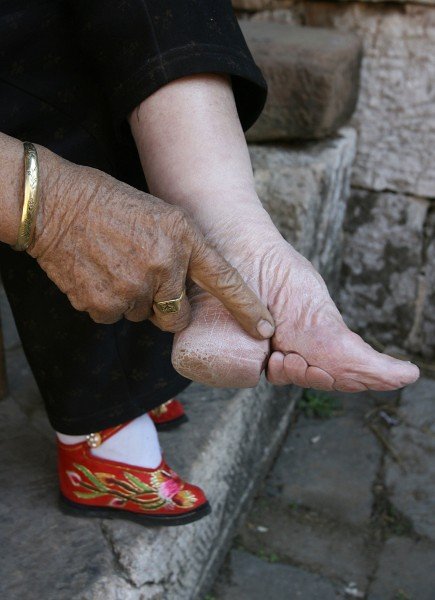
- calendar_month October 26, 2024
The ancient practice of foot binding, known as lotus feet, was a cultural tradition that endured in China for nearly a thousand years. This practice, primarily aimed at women of elite social classes, involved tightly binding the feet from a young age to shape them into small, arched forms that were seen as a mark of beauty, status, and elegance. Today, only a few women with bound feet remain, symbolizing the final remnants of this once-prevalent custom.
The Origins of Foot Binding
Foot binding is believed to have originated during the 10th century, in the Song Dynasty (960–1279), inspired by an emperor’s favorite concubine who danced on her toes wrapped in silk, resembling a lotus blossom. This style of walking, and the tiny, dainty feet that came with it, became a desirable trait among Chinese women. As the tradition spread, foot binding became a widespread custom among upper-class families, who believed that tiny feet enhanced a woman's beauty, social status, and marriage prospects.
Girls as young as four or five had their feet tightly bound with cloth to stunt growth, gradually reshaping their feet into an arched position, forcing the toes under the sole. Achieving the ideal size of a 3-inch “golden lotus” required immense pain and dedication, and the small, bound feet became synonymous with femininity and grace.
The Decline of Foot Binding
By the late 19th century, as China opened up to the world, attitudes toward foot binding began to shift. Missionaries, reformers, and medical professionals spoke out against the practice, highlighting the health issues and physical limitations it caused. Women with bound feet often endured lifelong pain, difficulty walking, and infections due to restricted blood flow. Anti-foot-binding societies were established, and by the early 20th century, the Qing government issued its first official ban on foot binding.
Although laws prohibiting the practice were passed, it persisted in rural areas for decades as some families still associated bound feet with cultural and social status. By the 1940s and 1950s, under the new communist government, foot binding was actively discouraged and seen as an outdated practice.
The Last Generation of Lotus Feet Women
Today, only a few elderly women with bound feet remain, most of them now in their 80s and 90s, marking the end of this tradition. These women, who endured the painful process of foot binding in their youth, offer a unique glimpse into a fading world. They represent not only a last link to a tradition that shaped Chinese culture for centuries but also a generation that has witnessed profound changes in Chinese society.
For these women, bound feet were a complex symbol of femininity, pride, and social standing. In rural villages, some recall that bound feet brought admiration and respect, while others reflect on the pain, physical limitations, and long-lasting health impacts of the practice. Today, as foot binding becomes a memory rather than a reality, these women serve as a poignant reminder of a tradition that, despite its painful consequences, played a significant role in the lives of generations of Chinese women.
Foot Binding’s Legacy in Modern China
In modern China, lotus feet are viewed with a mixture of fascination, regret, and respect for the resilience of the women who endured the practice. Museums, historians, and documentaries have begun preserving the history of foot binding, showcasing its cultural significance and the stories of the last generation of women who experienced it. Scholars and feminists have engaged in discussions around the practice, examining how societal expectations of beauty and status shaped the lives of women for centuries.
Foot binding is a reminder of the lengths to which people have historically gone in pursuit of social acceptance and beauty ideals. While the tradition is now a thing of the past, its legacy remains, offering an opportunity to reflect on how beauty standards have evolved and continue to impact women’s lives globally.
As the last generation of women with lotus feet gradually disappears, so too does a tangible connection to one of the most distinctive cultural practices in Chinese history. These women are living testaments to the resilience of the human spirit and the complex interplay of beauty, tradition, and societal expectations. While the practice of foot binding may be a closed chapter, the stories of these women ensure that this fascinating, and at times tragic, aspect of history will not be forgotten.
